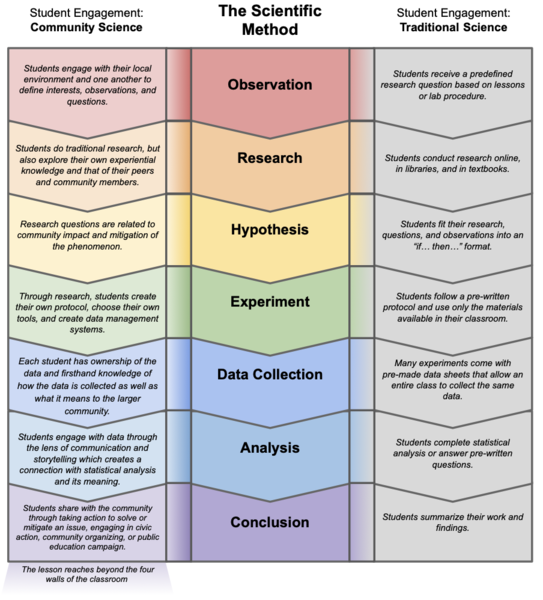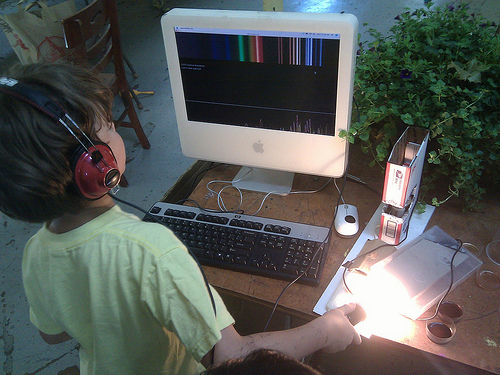#Welcome On this page you will find programming, activities, and resources related to formal and informal education. From here, you can: Join the conversation Learn how to integrate community science practices into your classroom Browse community science lesson plans from the Public Lab team Find activities for your classroom from the community Ask a question, answer a question, or follow future questions on education ## What Does Community Science Look Like in Your Classroom? Public Lab defines community science as community-led scientific exploration and investigation to address community-defined questions, allowing for engagement in the entirety of the scientific process. Unlike traditional citizen science, Public Lab’s approach emphasizes local and traditional knowledge, community ownership of research, and working together in scalable networks to encourage collaborative learning and civic engagement. [](/i/43663?s=o) Classroom community science projects are youth-led with an approach that emphasizes participant and community ownership of research, from question identification through analysis, and working together to encourage collaborative learning and civic engagement. After identifying their interests, students conduct research as they join the efforts of people and organizations already working on these issues and take the lead in aspects of study design, data collection, and analysis. The data collected from these student-designed projects supports community action and civic engagement. [Read more about integrating community science methodologies into your classroom here](https://publiclab.org/notes/mimiss/04-16-2021/community-science-in-the-classroom). **** ## How Can You Get Involved? We're looking to build a strong community of practice where educators of all experiences can share resources, knowledge, and lend a hand. Here are some ways that you can help build Public Lab's educational community ### Join the Conversation Get notified about new #education posts by subscribing to related tags. Click the button below, and subscribe to tags like "education", "classroom", "lesson", as well as other topics that you're interested in. Subscribe ### Try These Lessons in Your Classroom and Share Your Experience After using one of these activities in person, let us know how it goes in the comments. We appreciate your feedback and encourage you to share how you modify the lesson to better fit your classroom. - [Classroom Community Science](https://publiclab.org/wiki/student-led-community-science-in-the-classroom-a-curriculum): An adaptable curricula for bringing student-led environmental projects into your classroom. - [Messages from the Mississippi](https://publiclab.org/wiki/messages-from-the-mississippi-lesson-plans): A 6-part series investigating microplastics in local bodies of water culminating in student artwork and advocacy. - [Wetlands Remote Sensing & Management](https://publiclab.org/wiki/wetlands-lesson-plans): Hands on lesson plans to introduce students in grades 8-12 to oil spill cleanup, monitoring wetlands, and managing natural resources. - [Air Quality Class](https://publiclab.org/wiki/air-quality-class): An 8-week program in which students work with air quality sensors to monitor indoor air pollutants. Participants catalog and analyze the environmental air pollutant hazards that affect neighborhood homes and will share their findings with other community members ________________ ## Activities Here are some different activities particularly suited for use in the classroom: [activities:education] **** ## Questions [questions:education] **** ## Resources To learn more about the methods, successes, and challenges in developing these programs, check out our reports and evaluations from these funded projects: 2021 National Academy of Sciences Project Evaluation: Community Science in the Classroom 2022 EPA Impact Report: Messages from the Mississippi 2022 EPA Environmental Education Evaluation: Messages from the Mississippi **For more information on funding resources for educators, [click here](http://publiclab.org/wiki/funding-sources-for-science-teachers) ** [](/i/47464?s=o)...
| Author | Comment | Last activity | Moderation | ||
|---|---|---|---|---|---|
| amocorro | "@mimiss @purl - this is so neat! Definitely thought you should take a look. " | Read more » | almost 4 years ago | |||
| Ag8n | "Very good work. Another possible demonstration. I worked for a pharmaceutical company. We would check the incoming stoppers to see if they had b..." | Read more » | almost 4 years ago | |||
| mimiss | "This video has a great simple way to add an adjustable fly line that I think really makes this kite easier to fly. I'm sharing the video here and w..." | Read more » | over 4 years ago | |||
| pastinaik | "Memberikan informasi situs agen judi online terpercaya untuk permainan seperti bandarq, dominoqq, poker online uang asli dan deposit pulsa terbaik ..." | Read more » | over 4 years ago | |||
| dwhite01 | "The instructions for the Papercraft spectrometer Kit are terrible!!What part of the DVD are we supposed to use? by the way,a Dvd does not want to b..." | Read more » | almost 5 years ago | |||
| warren | ":-) Love this, Mimi! Keep up the great work! On Tue, Jun 4, 2019 at 2:36 PM \<notifications@publiclab.org> wrote: Public Lab contributor mi..." | Read more » | over 5 years ago | |||
| stevie | " @stevie has marked @mimiss as a co-author. " | Read more » | over 5 years ago | |||
| Ag8n | "What we were taught in industrial statistic s is that often times bimodal curves work themselves out into normal curves. How? Well, even if you h..." | Read more » | over 5 years ago | |||
| mimiss | "That's a great question, especially since there are many examples of things in nature that would have a bimodal distribution. A full rundown of st..." | Read more » | over 5 years ago | |||
| Ag8n | "You could easily have a bimodal distribution in your population. But, if you gather more data, who knows? It may turn out to be normal. Ok, how ..." | Read more » | over 5 years ago | |||
| mimiss | "Hello, thanks for that question! I think I should make some edits above to be more clear that box plots help us to identify potential outliers that..." | Read more » | over 5 years ago | |||
| Ag8n | "The common test for outliers in industry is the t-test. Is that the test codap is using? " | Read more » | over 5 years ago | |||
| warren | " Hi all! With help from @zengirl2, @asnow and @bronwen, we've posted a new Coqui activity with a smaller breadboard and flatter wiring here: https:..." | Read more » | almost 6 years ago | |||
| warren | "So just finally circling back here; I'm happy to post step-by-step photos and to put notes on all existing Coqui docs if we are pretty much OK with..." | Read more » | almost 6 years ago | |||
| SadiePrego | " @warren @Bronwen thanks so much you guys! " | Read more » | about 6 years ago | |||
| Bronwen | "@warren That's on me! I suggested breaking this up into a few posts just because the focus of activities are all so different and I wanted to make ..." | Read more » | about 6 years ago | |||
| warren | "Oh, oops, i see this isn't a duplicate at all, but split into three themes! My apologies, i am just always on the lookout to be sure our moderation..." | Read more » | about 6 years ago | |||
| warren | "Ah, looks like maybe it was posted twice because the first was held in moderation (sorry, our anti-spam systems are unfortunate, but you wouldn't b..." | Read more » | about 6 years ago | |||
| warren | " This looks tremendous. Very exciting -- thank you!!!! " | Read more » | about 6 years ago | |||
| warren | " " | Read more » | about 6 years ago | |||
| warren | "I tried doing a layout as @akshaya has done on a bigger board (https://publiclab.org/notes/ashkaya/09-17-2016/build-a-coqui-a-simple-water-conducti..." | Read more » | about 6 years ago | |||
| zengirl2 | "@warren I'm with @Liz that it looks cute. Also, on a Fritzing diagram I think this will be clear enough. It is actually easier to find the hole for..." | Read more » | about 6 years ago | |||
| roberts_ecofarm | "I think that crossing the wires over the top makes it harder to see which pins are connected. It does save space, but as a teaching aid I think it..." | Read more » | about 6 years ago | |||
| warren | "Nope, just thought it might be confusing in a diagram, but it saves space. On Tue, Nov 27, 2018, 4:51 PM \<notifications@publiclab.org wrote: ..." | Read more » | about 6 years ago |